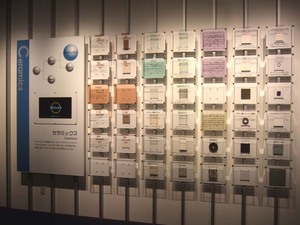Nagoya City Science Museum
TOP > Exhibition Guide > Keyword Search > Starting with "I" > ionic bond > Ceramics
Ceramics



Purpose of Exhibition
The main materials of industrial products are categorized into three groups: ceramics, metals and organic materials. Ceramics include earthenware (a plant pot or a roof tile), chinaware, firebrick, cement, enamel and glass. This exhibit features various test samples and videos to explain to you more about "ceramics".
Additional Knowledge
[What are Ceramics?]
The word ceramic comes from a Greek word meaning "earthenware", which is made from clay hardened in fire. Ceramics originally represented a simple pottery, but they now include "inorganic, non-metallic materials processed at high temperatures" and have been in wide use.
Comparing ceramics, metals and organic materials at the atomic level, we can say that a ceramic is an object produced when a metallic element and non-metallic element are bonded ionically or covalently. A metal is created when metallic elements are bonded metallically. Organic materials are covalently combined with non-metallic elements, such as carbon, hydrogen, oxygen and nitrogen.
Paying attention to the arrangement of atoms, there are some atoms which form a group of many crystals lined in a regular position, with a simple crystal, and whose arrangement looks irregular like a glass.
[Property of Ceramic]
Ceramics have many advantages: heat-resistant, rust-free, non-corrosive with chemicals, hard, and insulating. Scientific and chemical instruments such as the crucible and firebrick are good examples for making good use of the property which resists heat. Besides, for making use of the property that does not allow electricity through such as an insulator, an electric pole is a good example. On the other hand, ceramic is hard to process, and shock-sensitive.
[Fine Ceramics]
Ceramics in the old days were made from natural raw materials, including clay that primarily consisted of SiO2. But currently, using raw materials with high purity combined artificially and a new manufacturing method overcoming disadvantages, ceramic products with more precise and newer properties have been able to be developed. These are called "fine ceramics".
Since ceramics in the early days were breakable, they were difficult to be used in objects such as the blade of a knife. However, knives and scissors in the present day are made with fine ceramics. Cutting and shaving tools and machine parts are manufactured, making good use of its hardness advantage. IC packages, IC substrates and spark plugs are produced with the property of fine ceramics, which have high electric insulation. On the other hand, ceramic which allows electricity through has been developed and ceramic that acts like semiconductors are in use as a censor for various devices. Since it is safe for the human body, it has been widely accepted for artificial bone and dental materials. Furthermore, ceramics have been utilized for tiles as an insulation cover for space shuttles.
Thus, fine ceramics play an active role in many fields, from daily-use products to space development.
CooperationThe Ceramic Society of JapanNGK SPARK PLUG CO., LTD.
NGK INSULATORS, LTD.
ISHIZUKA GLASS CO., LTDArticle by Keiko Ishida, Curator
